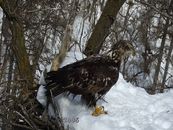 |
|
The Resident Couple |
 |
|
Intruder checking out the nest
|
Don’t count your eggs before they’re laid
The most frequent question we’ve been hearing lately is whether there will be eggs. If mating is an indication (it is), there will be. When eagles mate, there could be eggs within 5 to 10 days. Eagles begin mating in the fall and early winter here in Minnesota. Mating can happen for months before an egg is actually fertilized and then laid in the nest. The normal nesting period for bald eagles in Minnesota is during the month of March. The pair on this camera have nested as early as the first week in January to the last week in February, and have lost their clutch of eggs at each end of these extremes. The first camera year the clutch was lost due to extreme cold, and last spring's clutch was also lost, likely due to constant territorial disputes. When the parents are busy defending their territory, they are forced off of their nest, leaving the eggs uncovered and vulnerable.
Can you hear me now?
Not this year. Our new camera came equipped for sound, but the camera vendor was unable to get two different microphones to function last fall. The source of the malfunction is still a mystery, and now that courtship is well underway it is too late to disturb the nest and territory.
We will have our IT staff at the nest as soon as chicks leave this year - July or August - to run tests and get sound working for next season.
Whose nest is it, anyway?
There are at least four adult eagles that have been competing for the territory this season. The original "mom" who is wearing a band on her left leg, last year's male, and an additional unidentified pair that visit frequently. The female of this pair has an identifying dark feather on her forehead, and the male has a wound on the front of his neck - likely sustained in a territorial battle.
Some photographers have documented vicious battles between several adults and juvenile eagles in the area of our nest. Territorial disputes are common in the wild and help to strengthen the species' population. The strongest birds will prevail in a fight, they will reproduce and their dominant DNA will be passed to their offspring.
We don't know which birds will dominate the nest this year, but we are confident there will be eggs and eagle chicks to watch this season. Stay tuned to EagleCam to keep up with the drama!
The Nongame Wildlife Program depends on donations to keep your EagleCam going. Please tell your tax preparer that you would like to make a tax-deductible donation when filling out your tax form. Or, make a donation right now at: NongameDonation. We sincerely thank you for any amount you give, it all makes a difference in the life of Minnesota's animals!
 |
|
Pair protecting nest
|
|